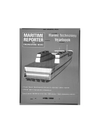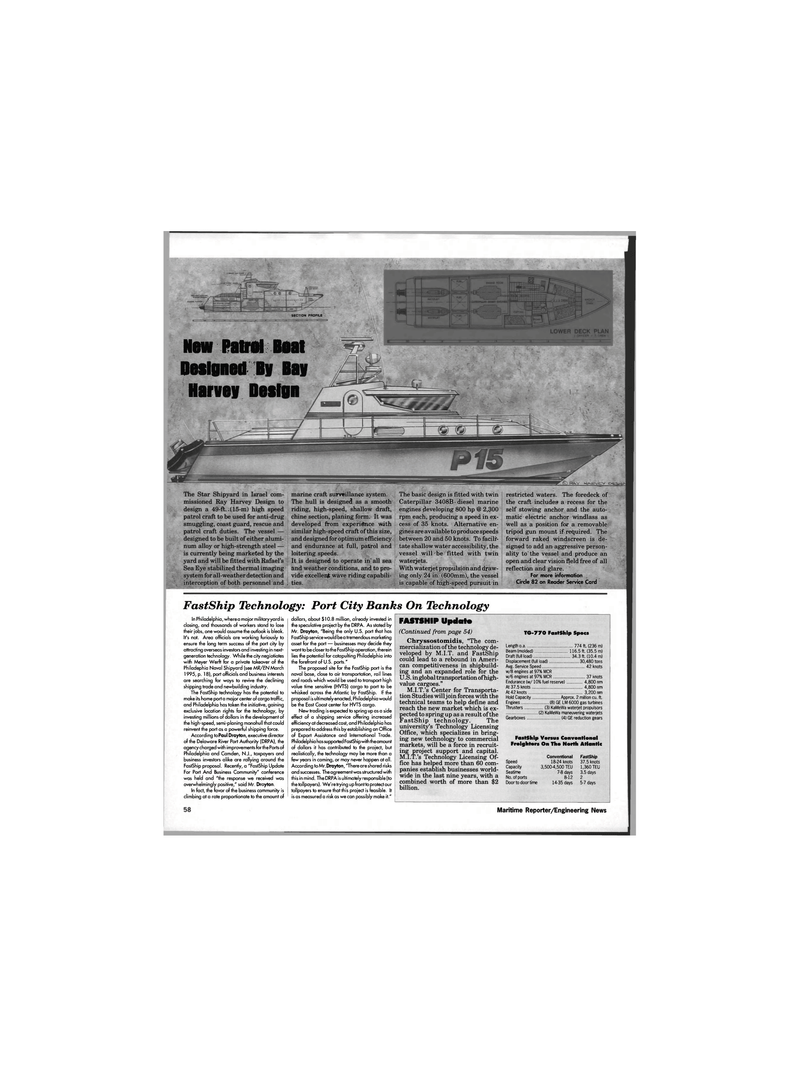
Page 48: of Maritime Reporter Magazine (April 1995)
Read this page in Pdf, Flash or Html5 edition of April 1995 Maritime Reporter Magazine
SECTION PROFILE
New Patrol Boat
Designed By Bay
Harvey Design
The Star Shipyard in Israel com- missioned Ray Harvey Design to design a 49-ft. (15-m) high speed patrol craft to be used for anti-drug smuggling, coast guard, rescue and patrol craft duties. The vessel — designed to be built of either alumi- num alloy or high-strength steel — is currently being marketed by the yard and will be fitted with Rafael's
Sea Eye stabilized thermal imaging system for all-weather detection and interception of both personnel and I marine craft surveillance system.
The hull is designed as a smooth riding, high-speed, shallow draft, chine section, planing form. It was developed from experience with similar high-speed craft of this size, and designed for optimum efficiency and endurance at full, patrol and loitering speeds.
It is designed to operate in' all sea and weather conditions, and to pro- vide excellent wave riding capabili- ties.
The basic design is fitted with twin
Caterpillar 3408B diesel marine engines developing 800 hp @ 2,300 rpm each, producing a speed in ex- cess of 35 knots. Alternative en- gines are available to produce speeds between 20 and 50 knots. To facili- tate shallow water accessibility, the vessel will be fitted with twin wateijets.
With wateijet propulsion and draw- ing only 24 in. (600mm), the vessel is capable of high-speed pursuit in restricted waters. The foredeck of the craft includes a recess for the self stowing anchor and the auto- matic electric anchor windlass as well as a position for a removable tripod gun mount if required. The forward raked windscreen is de- signed to add an aggressive person- ality to the vessel and produce an open and clear vision field free of all reflection and glare.
For more information
Circle 82 on Reader Service Card
FastShip Technology: Port City Banks On Technology
In Philadelphia, where a major military yard is closing, and thousands of workers stand to lose their jobs, one would assume the outlook is bleak.
It's not. Area officials are working furiously to ensure the long term success of the port city by attracting overseas investors and investing in next- generation technology. While the city negiotiates with Meyer Werft for a private takeover of the
Philadephia Naval Shipyard (see MR/EN March 1995, p. 18), port officials and business interests are searching for ways to revive the declining shipping trade and newbuilding industry.
The FastShip technology has the potential to make its home port a major center of cargo traffic, and Philadelphia has taken the initiative, gaining exclusive location rights for the technology, by investing millions of dollars in the development of the high-speed, semi-planing monohull that could reinvent the port as a powerful shipping force.
According to Paul Drayton, executive director of the Delaware River Port Authority (DRPA), the agency charged with improvements for the Ports of
Philadelphia and Camden, N.J., taxpayers and business investors alike are rallying around the
FastShip proposal. Recently, a "FastShip Update
For Port And Business Community" conference was held and "the response we received was overwhelmingly positive," said Mr. Drayton.
In fact, the favor of the business community is climbing at a rate proportionate to the amount of dollars, about $10.8 million, already invested in the speculative project by the DRPA. As stated by
Mr. Drayton, "Being the only U.S. port that has
FastShip service would be a tremendous marketing asset for the port — businesses may decide they want to be closer to the FastShip operation, therein lies the potential for catapulting Philadelphia into the forefront of U.S. ports."
The proposed site for the FastShip port is the naval base, close to air transportation, rail lines and roads which would be used to transport high value time sensitive (HVTS) cargo to port to be whisked across the Atlantic by FastShip. If the proposal is ultimately enacted, Philadelphia would be the East Coast center for HVTS cargo.
New trading is expected to spring up as a side effect of a shipping service offering increased efficiency at decreased cost, and Philadelphia has prepared to address this by establishing an Office of Export Assistance and International Trade.
Philadelphia has supported FastShip with theamount of dollars it has contributed to the project, but realistically, the technology may be more than a few years in coming, or may never happen at all.
According to Mr.Drayton, "There are shared risks and successes. The agreement was structured with this in mind. The DRPA is ultimately responsible (to thetollpayers). We'retryingupfronttoprotectour tollpayers to ensure that this project is feasible. It is as measured a risk as we can possibly make it."
FASTSHIP Update (Continued from page 54)
Chryssostomidis, "The com- mercialization of the technology de- veloped by M.I.T. and FastShip could lead to a rebound in Ameri- can competitiveness in shipbuild- ing and an expanded role for the
U.S. in global transportation of high- value cargoes."
M.I.T.'s Center for Transporta- tion Studies will join forces with the technical teams to help define and reach the new market which is ex- pected to spring up as a result of the
FastShip technology. The university's Technology Licensing
Office, which specializes in bring- ing new technology to commercial markets, will be a force in recruit- ing project support and capital.
M.I.T.'s Technology Licensing Of- fice has helped more than 60 com- panies establish businesses world- wide in the last nine years, with a combined worth of more than $2 billion.
TG-770 FastShip Specs
Length o.a 774 ft. (236 m)
Beam (molded) 116.5 ft. (35.5 m)
Draft (full load) 34.3 ft. (10.4 m)
Displacement (full load) 30,480 tons
Avg. Service Speed 42 knots w/8 engines at 97% MCR w/6 engines at 97% MCR 37 knots
Endurance (w/10% fuel reserve) 4,800 nm
At 37.5 knots 4,800 nm
At 42 knots 3,200 nm
Hold Capacity Approx. 2 million cu. ft.
Engines (8) GE LM 6000 gas turbines
Thrusters (3) KaMeWa waterjet propulsors (2) KaMeWa maneuvering waterjets
Gearboxes (4) GE reduction gears
FastShip Versus Conventional
Freighters On The North Atlantic
Conventional FastShip
Speed 18-24 knots 37.5 knots
Capacity 3,500-4,500 TEU 1,360 TEU
Seatime 7-8 days 3.5 days
No. of ports 8-12 2
Door to door time 14-35 days 5-7 days 50 Maritime Reporter/Engineering News

 47
47

 49
49
